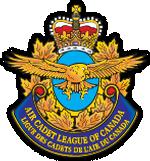Air Cadet League of Canada

"The Air Cadet League of Canada program has developed the attributes of good citizenship and leadership in Canadian youth while stimulating their interests in aeronautics and assisting in their pursuits of careers to the betterment of Canadian aviation."
The Air Cadet League of Canada is a non-profit, civilian organization composed of leading business and professional people from all parts of Canada. The League functions through a national board of governors, provincial and regional directors, and local sponsoring bodies supporting each squadron. The League is aimed at providing citizenship and aviation training for Canadian youths in high school.
In early 1937, as war clouds started forming in Europe, several prominent men, mostly World War I veterans from the air division of the Royal Canadian Navy (RCN) and Royal Air Force (RAF), across Canada independently conceived the idea of establishing Air Cadet Squadrons in their home cities as a means of interesting the young men of the day in the possibility of future service with the Royal Canadian Air Force.
In 1939 the Federal Air Advisory Council appointed S/L Nick Carter of Vancouver, British Columbia, to organize the youth of the country in an Air Cadet Organization. He personally traveled across Canada expounding on the merits of such a program, which ultimately led to Air Minister Powers sponsoring Order-in-Council PC 6647, which passed on November 11, 1940, and authorized the formation of the Air Cadet League of Canada.
In April, 1941, the Air Cadet League of Canada was granted a Dominion Charter and many squadrons were formed across the country. Over 3,000 cadets graduated into the RCAF and their gallant record in all theatres of the allied war operations provided tangible proof of the value of Air Cadet training towards Canada's war efforts.
Following World War II, there was a natural lessening of interest in Cadet activities and the organization floundered somewhat. In 1946 the Canadian government implemented a plan of sponsoring 15,000 Air Cadets, and a peacetime program was adopted to combine citizenship training along with aviation instruction.
In addition, a scholarship program was established whereby all senior Cadets could compete annually for 250 positions to train for a Transport Canada Private Pilot Licence. Within this program, successful Cadets were provided with six weeks of powered flight instruction at various flying schools across the country during their summer holidays.
In 1968 the League lost its original partner, the RCAF, due to unification of the Canadian Armed Forces. The League adopted gliding instruction as part of their program in order to keep the "air" in Air Cadets and provide more flight instruction to the Cadet membership. More than 45,000 glider flights have been carried out each year since that time and over 320 Air Cadet glider pilots are licenced annually. Presently, the League owns more than 50 gliders and 27 tow planes which are operated by the Department of National Defence in support of the League's training program.
In 1975 membership was opened to include girls, thereby extending the Air Cadet training influence to the total youth of Canada. In 1989 there were over 440 squadrons operating across Canada, and 30 per cent of the membership was comprised of young women.
The Belt of Orion Award for Excellence was bestowed upon the Air Cadet League of Canada in 1989 at a ceremony held in Edmonton, Alberta.
It is significant to note that in 1981, His Royal Highness Prince Phillip, Air-Commodore-in-Chief, Royal Canadian Air Cadets, congratulated the League on its 40th anniversary. He especially emphasized that the training provided by the Air Cadet League of Canada does much more than foster an interest in aviation, it is equally important as a preparation for responsible citizenship.
